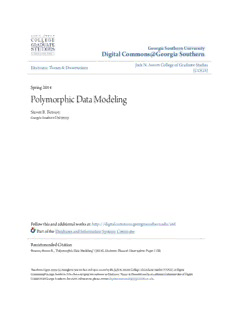
Polymorphic Data Modeling PDF
Preview Polymorphic Data Modeling
Georgia Southern University Digital Commons@Georgia Southern Electronic Theses and Dissertations Graduate Studies, Jack N. Averitt College of Spring 2014 Polymorphic Data Modeling Steven R. Benson Follow this and additional works at: https://digitalcommons.georgiasouthern.edu/etd Part of the Databases and Information Systems Commons Recommended Citation Benson, Steven R., "Polymorphic Data Modeling" (2014). Electronic Theses and Dissertations. 1126. https://digitalcommons.georgiasouthern.edu/etd/1126 This thesis (open access) is brought to you for free and open access by the Graduate Studies, Jack N. Averitt College of at Digital Commons@Georgia Southern. It has been accepted for inclusion in Electronic Theses and Dissertations by an authorized administrator of Digital Commons@Georgia Southern. For more information, please contact [email protected]. 1 POLYMORPHIC DATA MODELING by STEVEN BENSON (Under the Direction of Vladan Jovanovic) ABSTRACT There are currently no data modeling standards for modeling NoSQL document store databases. This work proposes a standard to fill the void. The proposed standard is based on our new data modeling pattern named The Polymorphic Table Pattern. The pattern embraces the “schemaless” nature of document store NoSQL while allowing the data modeler to use his or her existing skillsets. The concepts of our proposed modeling have been demonstrated against MongoDB. INDEX WORDS: Polymorphism, Data modeling, NoSQL, IDEF1X, MongoDB, Document store 2 POLYMORPHIC DATA MODELING by STEVEN BENSON B.S., Winthrop University, 1998 A Thesis Submitted to the Graduate Faculty of Georgia Southern University in Partial Fulfillment of the Requirements for the Degree MASTER OF SCIENCE STATESBORO, GEORGIA 3 ©2014 STEVEN BENSON All Rights Reserved 4 POLYMORPHIC DATA MODELING By STEVEN BENSON Major Professor: Vladan Jovanovic Committee: Lixin Li Wenjia Li Electronic Version Approved: May, 2014 5 DEDICATION To my Lord and Savior Jesus Christ, to whom I give all the honor and credit for the Polymorphic Table modeling pattern. I thank You for entrusting this wonderful discovery to me. 6 ACKNOWLEDGEMENTS I would like to thank Dr. Vladan Jovanovic for his patience, time, and wisdom for helping through this process. I have appreciated all the guidance that he has provided over the years. Last but not least, I would like to thank my family. I would especially like to say thank you to my beautiful and loving wife, who encouraged me to complete my degree when I felt like giving up. I would also like to thank my two beautiful little girls who have loved me unconditionally even though our family time was reduced while I was in the master’s program. Daddy loves you. 7 Table of Contents ACKNOWLEDGEMENTS………………………………………………………………………………………………………………………………………..6 LIST OF TABLES ………………………………………………………………………………………………………………………………………………….11 LIST OF FIGURES………………………………………………………………………………….................................................................12 CHAPTER 1 ............................................................................................................................................................... 14 1.1 Purpose of Study………………………………………………………………………………………………………………………………………14 CHAPTER 2 ............................................................................................................................................................... 17 2.1 NoSQL Data Modeling ………………………………………………………………………………………………………………………..17 2.2 Conceptual XML Data Modeling……………………………………………………………………………………………………………….17 2.3 E-R Model Based Approaches ……………………………………………………………………………………………………………18 2.4 Hierarchical Based Approaches………………………………………………………………………………………………………………..20 CHAPTER 3 ............................................................................................................................................................... 21 3.1 General ……………………………………………………………………………………………………………………………………………….…21 3.2 Embedding………………………………………………………………………………………………..................................................21 3.2.1 One to One Relationship ........................................................................................................................ 21 3.2.2 One to Many Relationship ..................................................................................................................... 22 3.3 References……………………………………………………………………………………………………………………………………………….23 3.3.1 One to Many Relationships .................................................................................................................... 23 3.4 Comparisons to XML Schema Styles………………………………………………………………………………………………………...25 3.4.1 Embedded vs Russian Doll ..................................................................................................................... 25 3.4.2 References vs Russian Doll ..................................................................................................................... 26 3.4.3 Embedded vs Salami Slice ...................................................................................................................... 26 3.4.4 References vs Salami Slice ..................................................................................................................... 26 3.4.5 Embedded vs Venetian Blind ................................................................................................................. 26 3.4.6 References vs Venetian Blind................................................................................................................. 26 3.4.7 Embedded vs Garden of Eden................................................................................................................ 26 3.4.8 References vs Garden of Eden ............................................................................................................... 27 CHAPTER 4 ............................................................................................................................................................... 28 4.1 Overview………………………………………………………………………………………………………………………………………………….28 4.2 General NoSQL Data Model Requirements………………………………………………………………………………………………28 4.2.1 NoSQL Implementation Agnosticism ..................................................................................................... 28 8 4.2.2 Formal Foundations ............................................................................................................................... 28 4.2.3 Data Description .................................................................................................................................... 28 4.2.4 Hierarchical Representation .................................................................................................................. 28 4.2.5 Graphical Representation ...................................................................................................................... 29 4.3 Data Modeling Construct Requirements…………………………………………………………………………………………………..29 4.3.1 Entity Identification ............................................................................................................................... 29 4.3.2 Identifying Property ............................................................................................................................... 29 4.3.3 Unique Property Constraint ................................................................................................................... 29 4.3.4 Required/Optional Property .................................................................................................................. 29 4.3.5 Data Type Property ................................................................................................................................ 29 4.3.6 Complex Objects .................................................................................................................................... 30 4.3.7 Cardinality .............................................................................................................................................. 30 CHAPTER 5 ............................................................................................................................................................... 31 5.1 Overview.......................................................................................................................................................31 5.2 New Approach: Polymorphic Pattern Formalization and Explanation……………………………............................32 5.2.1 Polymorphic Table Entity (PTE) .............................................................................................................. 32 5.2.2 Polymorphic Table Column (PTC) .......................................................................................................... 32 5.2.3 Polymorphic Table Column Simple (PTCS) ............................................................................................. 33 5.2.4 Polymorphic Table Column Value Simple (PTCVS) ................................................................................ 33 5.2.5 Polymorphic Table Column Complex (PTCC) ......................................................................................... 33 5.2.6 Polymorphic Table Column Attribute (PTCA) ........................................................................................ 34 5.2.7 Polymorphic Table Column Value Complex (PTCVC) ............................................................................. 34 5.2.8 Polymorphic Table Child Column Bridge (PTCCB) .................................................................................. 34 5.2.9 Polymorphic Table to Polymorphic Table Bridge (PTB) and Owner Container (OC) ............................. 35 5.2.10 Standalone Polymorphic Table Entity (SPTE) ....................................................................................... 35 CHAPTER 6 ............................................................................................................................................................... 36 6.1 Relational Model (RM) Example……………………………………………………………………………………………………………….36 6.2 RM to Logical Model Transformation – Parent Entity ……………………………………………………………………..36 6.3 RM to Logical Model Transformation – Super-type and Subtype………………………………….............................37 6.4 RM to Logical Model Transformation – PTE’s Dependent Entity……………………………………………………………...39 6.5 RM to Logical Transformation – PTB and OC................................................................................................40 6.6 Physical Modeling Application…………………………………………………………………………………………………………………41 6.6.1 Table Renaming ..................................................................................................................................... 41 9 6.6.2 Polymorphic Table Key Specification ..................................................................................................... 41 6.6.3 SQL Data Type Specification .................................................................................................................. 42 6.6.4 Detailed Primary Key Specification ........................................................................................................ 43 6.6.5 Detailed Index Specification .................................................................................................................. 43 6.6.6 Referenced Attribute Identification ....................................................................................................... 44 CHAPTER 7 ............................................................................................................................................................... 45 7.1 Meta-schema Approach Explanation…………………………………………………………………........................................45 7.1.1 Schema.table.global.columns Collection ............................................................................................... 46 7.1.2 Schema.tables Collection ....................................................................................................................... 46 7.1.3 Schema.table.containers Collection ...................................................................................................... 46 7.1.4 Schema.table.columns.simple Collection .............................................................................................. 47 7.1.5 Schema.table.columns.complex Collection ........................................................................................... 47 CHAPTER 8 ............................................................................................................................................................... 49 8.1 Model Requirements Implementation……………………………………………………………………………………………………..49 8.1.1 General NoSQL Data Model Requirements ........................................................................................... 49 8.1.2 Modeling Constructs .............................................................................................................................. 50 8.2 Meta-Schema Enforced Documents (Experimental Data)…………………………………………………………………………52 8.2.1 PT_Project Document Validation ........................................................................................................... 52 8.2.2 PT_ContractChangeOrder Document Validation ................................................................................... 55 CHAPTER 9 ............................................................................................................................................................... 57 9.1 Required Skillset – IDEF1x………………………………………………………………………………………………………………………..57 9.2 Required Skillset – Data Model Refactoring……………………………………………………………………………………………..58 9.3 Required Skillset – XML…………………………………………………………………………………………………………………………...59 CHAPTER 10 ............................................................................................................................................................. 61 Bibliography…………………………………………………………………………………………………………………………………………………..62 APPENDIX A……………………………………………………………………………………………………………………………………………………65 A.1 Meta-schema Collection – Schema.tables…………………………………………………………………………………………...65 A.2 Meta-schema Collection – Schema.table.containers…………………………………………………………………………...66 A.3 Meta-schema Collection – Schema.table.global.columns…………………………………………………………………….68 A.4 Meta-schema Collection – Schema.table.columns.simple……………………………………………………………………69 A.5 Meta-schema Collection - table.columns.complex………………………………………………………………………………72 APPENDIX B…………………………………………………………………………………………………………………………………………………..78 B.1 MongoDB…………………………………………………………………………………………………………………………………………….78
Description: